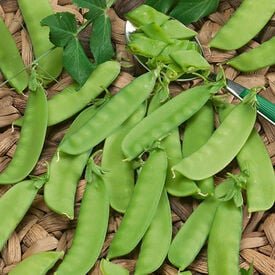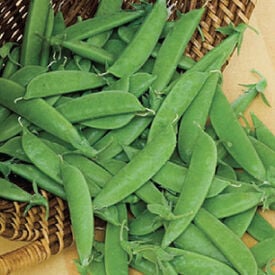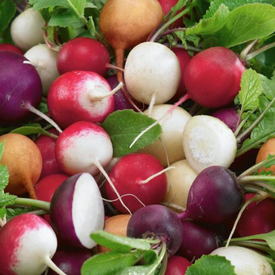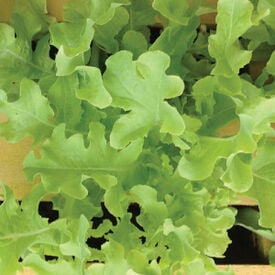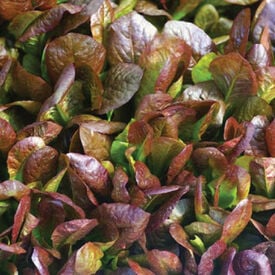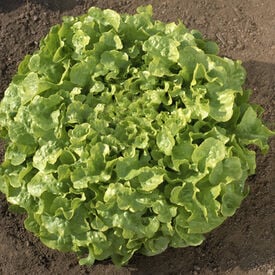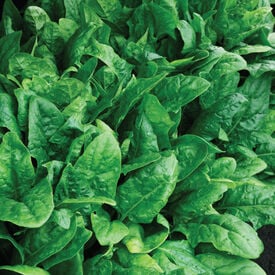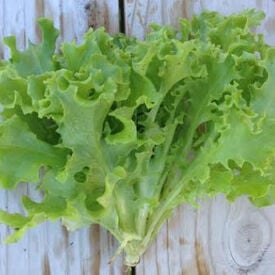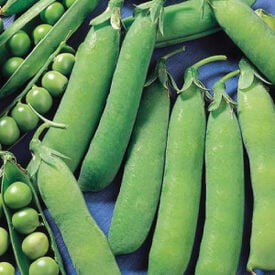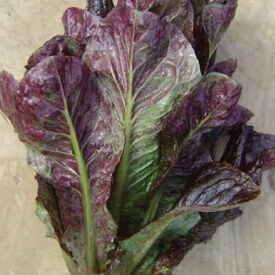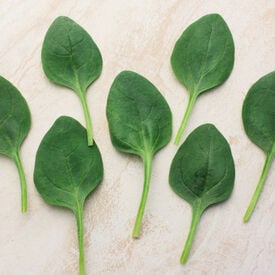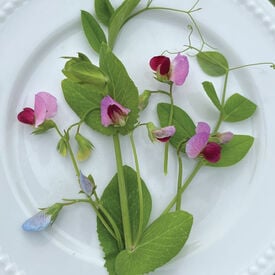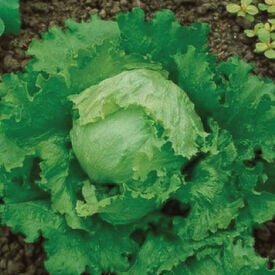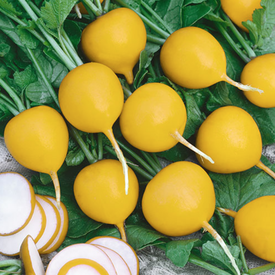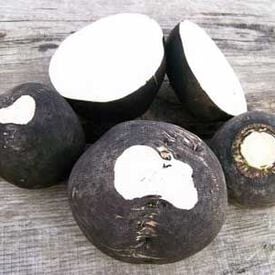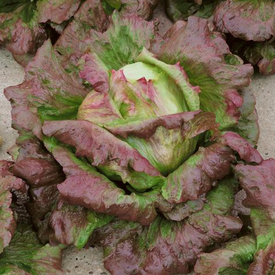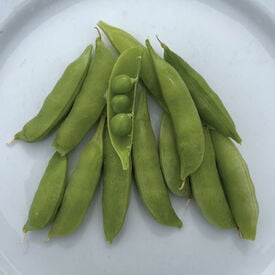The Mammoth Melting Pea is a snow pea that adds the perfect mouthwatering crunch to any salad! The 5-6 foot tall vines require trellising for support. This variety's large sweet pods thrive in the cooler weather. Add a fresh pop of bright green to any garden or dish with the Mammoth Melting! Certified Organic. Learn more about our organic seeds.
The Super Sugar Pea is an improved original tall snap pea that is bursting with a sugary sweet flavor! This plant variety has a very high yield potential and even better flavor than before being improved, making it a favorite to add to many dishes.
The Fiesta Blend is a five color radish blend of red, pink, yellow, white and purple! This colorful blend will be sure to a pop of fun color to any garden. Serving up the Fiesta Blend in salads or dishes is a great addition to any party or gathering!
The Green Salad Bowl is a decorative rosette type of lettuce with closely set crispy leaves. This looseleaf lettuce's crumpled leaves hold water very well, making it a popular variety!
The Cimarron is a very beautifully colored romaine lettuce! This tasty lettuce has bright green-red leaves that fade to deep red tips. This romaine type lettuce has good disease and bolt resistance. Cimarron is a favorite among gardeners for its beautiful hue and crispy texture in salad mixes!
The Oakleaf Lettuce gets its name for having very tender leaves that resemble the white oak leaf. This variety is an old time favorite that tastes great in mixed salads. The Oakleaf is perfect for planting late in the season. This lettuce will stay tasty and non-bitter well into the heat of summer!
Plymouth spinach is a new variety that is great for processing or fresh market growing. It has smooth, medium-dark green leaves that are uniform in shape and size. Plymouth is a moderate to fast-growing variety and has great yield potential.
Tango Lettuce is a fun curled baby leaf lettuce variety! This lettuce has a crisp clean texture and holds up well with numerous salad dressings. This attractive uniform plant forms tight erect rosettes that are 12" across and 6-8" tall. Tango is an oak leaf variety.
Wando pea seeds are a popular heirloom variety known for their cold tolerance and early harvest. They produce vibrant green, sweet-tasting peas that are perfect for fresh eating, freezing, or cooking. The seeds grow into plants that are typically 18-24 inches tall, making them ideal for small gardens or containers. Wando peas are well-suited for cooler climates, as they can withstand light frosts and thrive in temperatures between 55°F and 75°F. With a quick maturation time of about 60-70 days, they are a great choice for gardeners looking to enjoy peas early in the growing season. Their resilience and ease of growth make them a favorite among both beginner and experienced gardeners.
Red Romaine Lettuce has long, crinkled leaves with great crunch! This variety starts green and fades to redish-purple. The Red Romaine's leaves are12" tall and the plant is about 10-12" wide. This lettuce is often used in Caesar salads not only for its crunch, but also for its color. Use Red Romaine lettuce for an incredible edible purple border in your flower beds.
Lakeside smooth leaf spinach with dark green leaves. It has a round to oval leaf shape with an upright plant habit that makes it easy to harvest. It is a very versatile variety it can be used for baby leaf, bunch or clip.
The Dwarf Grey Sugar Pea is one of our customer favorite peas! Produces an abundance of attractive purple and blue flowers. These flowers are edible, have a light pea flavor and look great on many dishes. The mature peas are very flavorful and is ideal for steaming, stir-frying or eating fresh out of the garden. Dwarf Grey Sugar Pea is suitable for northern and southern regions, as it is tolerant to heat and cold.
Great Lakes 118 lettuce is a classic butterhead variety that has gained popularity among gardeners since its introduction in the mid-20th century. Known for its compact, dense heads and vibrant green, slightly crinkled leaves, this lettuce offers a pleasing texture and rich, buttery flavor. The taste is mildly sweet and crisp, making it ideal for salads and sandwiches. Harvesting typically occurs around 60-75 days after planting, when the heads are firm and fully developed; gardeners can either cut the entire head or pick individual leaves as needed. Great Lakes 118 thrives in cooler temperatures and well-drained soil, making it a favorite choice for spring and fall planting, and it’s particularly valued for its ability to withstand heat and maintain flavor.
The Golden Helios Radish is named after the Greek god of the sun. This olive-shaped radish is bright yellow with a crispy white flesh and is truly one of the most beautiful radish! Not only is Helios a beauty, it is also tasty with a sweet and mild flavor.
Little Gem lettuce is a small, compact variety that belongs to the Romaine family. Known for its tender, crisp leaves and sweet, mild flavor, it has become a favorite in both casual and fine dining. The heads are typically about the size of a fist, with tightly packed, bright green leaves that are both crunchy and delicate. Its flavor is a perfect balance between the slightly bitter taste of Romaine and the mild sweetness of Butterhead lettuce. Little Gem is often used in salads, sandwiches, or as a base for grilling, where its natural sweetness intensifies. Its small size also makes it an ideal choice for individual servings or garnishes. Rich in vitamins A, C, and K, it’s not only flavorful but also nutritious. Little Gem's heads are about 4 inches across and are prime eating from 4-6 inches tall. The plants can be spaced 6 1/2 by 6 1/2 inches for maximum yields. Growing Little Gem lettuce is relatively easy and well-suited to home gardeners, thriving in cool, temperate climates. This compact variety of lettuce prefers full sun but can tolerate partial shade, especially in hotter weather. It grows best in well-drained, fertile soil with a slightly acidic to neutral pH. To plant, sow seeds directly into the soil in early spring or late summer, spacing them about 6-8 inches apart to allow for proper air circulation and growth. Little Gem lettuce thrives with regular watering, but it’s important to avoid waterlogging, as this can lead to root rot. As it matures, the small heads form tight, crisp rosettes. Harvesting can begin in around 30-45 days, typically when the heads are firm but still small. For continuous harvest, sow new seeds every couple of weeks. Little Gem lettuce is also ideal for container gardening due to its compact size, making it a great choice for small spaces or urban gardens.
Black Spanish Round Radish is a unique black old heirloom that has a nutty and slightly spicy flavor! This black beauty radish is making a comeback! Its firm flesh holds up well in meals. The Black Spanish Round is best grown from late winter to early spring and is a healthy spring vegetable.
The Chrystal Batavian Lettuce is known for its beautifully colored leaves! This lettuce's coloring has a bright purplish red contrast on broad green loose leaves. The Chrystal Batavian is a summer crisp type of lettuce.
Sugar Sprint Pea will sprint into the production of delicious peas! This fast maturing, heavy producing pea plant is one of the earliest maturing peas available. This pea variety produces 3" stringless snap peas over a long period. Sugar Sprint is heat tolerant and resistant to powdery mildew.
